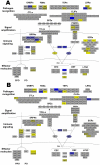Wolbachia infections in Anopheles gambiae cells: transcriptomic characterization of a novel host-symbiont interaction
- PMID: 21379333
- PMCID: PMC3040664
- DOI: 10.1371/journal.ppat.1001296
Wolbachia infections in Anopheles gambiae cells: transcriptomic characterization of a novel host-symbiont interaction
Abstract
The endosymbiotic bacterium Wolbachia is being investigated as a potential control agent in several important vector insect species. Recent studies have shown that Wolbachia can protect the insect host against a wide variety of pathogens, resulting in reduced transmission of parasites and viruses. It has been proposed that compromised vector competence of Wolbachia-infected insects is due to up-regulation of the host innate immune system or metabolic competition. Anopheles mosquitoes, which transmit human malaria parasites, have never been found to harbor Wolbachia in nature. While transient somatic infections can be established in Anopheles, no stable artificially-transinfected Anopheles line has been developed despite numerous attempts. However, cultured Anopheles cells can be stably infected with multiple Wolbachia strains such as wAlbB from Aedes albopictus, wRi from Drosophila simulans and wMelPop from Drosophila melanogaster. Infected cell lines provide an amenable system to investigate Wolbachia-Anopheles interactions in the absence of an infected mosquito strain. We used Affymetrix GeneChip microarrays to investigate the effect of wAlbB and wRi infection on the transcriptome of cultured Anopheles Sua5B cells, and for a subset of genes used quantitative PCR to validate results in somatically-infected Anopheles mosquitoes. Wolbachia infection had a dramatic strain-specific effect on gene expression in this cell line, with almost 700 genes in total regulated representing a diverse array of functional classes. Very strikingly, infection resulted in a significant down-regulation of many immune, stress and detoxification-related transcripts. This is in stark contrast to the induction of immune genes observed in other insect hosts. We also identified genes that may be potentially involved in Wolbachia-induced reproductive and pathogenic phenotypes. Somatically-infected mosquitoes had similar responses to cultured cells. The data show that Wolbachia has a profound and unique effect on Anopheles gene expression in cultured cells, and has important implications for mechanistic understanding of Wolbachia-induced phenotypes and potential novel strategies to control malaria.
Conflict of interest statement
The authors have declared that no competing interests exist.
Figures



References
-
- Werren JH, Baldo L, Clark ME. Wolbachia: master manipulators of invertebrate biology. Nat Rev Microbiol. 2008;6:741–751. - PubMed
-
- Moreira LA, Iturbe-Ormaetxe I, Jeffery JA, Lu G, Pyke AT, et al. A Wolbachia symbiont in Aedes aegypti limits infection with Dengue, Chikungunya, and Plasmodium. Cell. 2009;139:1268–1278. - PubMed
-
- Hedges LM, Brownlie JC, O'Neill SL, Johnson KN. Wolbachia and virus protection in insects. Science. 2008;322:702–702. - PubMed
Publication types
MeSH terms
Substances
Grants and funding
LinkOut - more resources
Full Text Sources
Medical
Molecular Biology Databases

